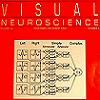
Welcome to my website. I’m Jenny Read, a Professor of Vision Science at Newcastle University.
I’m currently on secondment to the Advanced Research + Invention Agency (ARIA), a new funding agency built to unlock scientific and technological breakthroughs to benefit everyone. I’m one of eight founding Programme Directors tasked with designing and overseeing ARIA’s R&D programmes. These span a range of fields, but are deliberately bold, and will bring together different disciplines and institutions. I’m currently developing a programme in robotics. If you’d like to learn more or engage in the programme, please get in touch through ARIA, here.
In my research work at Newcastle University to date, a particular interest has been binocular and stereoscopic vision, also known as stereopsis. As sketched out here, I’ve studied pretty much all aspects of this ability, ranging from detailed psychophysical measurements of depth perception, to computational models of the underlying neuronal mechanisms, to stereopsis in other species, to clinical disorders of vision, to commercial applications of 3D display technologies. My lab developed the ASTEROID stereotest, which is currently in use by a number of labs worldwide. More recently, I’ve become interested in oculomotor aspects of vision, including fixational eye movements, vergence and accommodation. I’m also part of the OCTAHEDRON team, a group of computer scientists, ophthalmologists and neuroscientists here in the North East aiming to use AI to detect neuropathology from OCT retinal images.
You can use the tabs above to navigate these pages. You’ll find all my published papers and details of talks given by me and other lab members. There’s also Matlab code relating to many of my publications. You can find videos of me talking about my own work, or vision science in general, on my YouTube channel. I also make occasional blog posts. Here are links to my ORCID and Google Scholar profiles.
A lot of my research has used volunteers who participate in my experiments probing human vision. If you have volunteered in one of my experiments, thank you so much! We couldn’t do it without you. I have a page specially for people who have participated in my research, where I explain what we have learnt with your help.
For non-ARIA work, my Newcastle email is jenny.read@newcastle.ac.uk; for ARIA, please use their contact form.
News from the lab |
Archive |





















Hello dear Jenny,
I took the liberty to publish a small paper about your mantis research in my newletter.
Do not hesitate to comment and react.
My newletter is sent once a week to 1600 3D fans around the world, so accuracy is important. Do not hesitate to pinpoint any mistake!
also not hat I am a member of the scientific committee of the 3DStereomedia scientific conference, the European conference about 3D.
If you have a good paper to submit, it will be a pleasure to meet you in Liege in December 2014.
Regards,
Benoit Michel
StereoscopyNews Editor
+32 498 93 7058
reference :
http://www.stereoscopynews.com/hotnews/3d-technology/research-projects/3674-praying-mantis-wears-world-s-smallest-3d-glasses-and-goes-to-the-3d-movies.html
Thanks for your interest in our work, Benoit, I hope the readers of Stereoscopy News find it interesting! They might be interested in the project’s FAQ.
Best wishes, Jenny
Unfortunately the video of your experiment, that I found on the website of the Huffington Post, is not in stereoscopy. I think that a stereoscopic video report of your experiment would be much more convincing.
Best regards, Olivier (author of two books on stereoscopy, 1990 and an update in 2011)
Ha, you’re right, Olivier! We will have to film it in 3D next time.
Best wishes, Jenny.
Hi Jenny, I am a 7th grader in the US. For my science project I am studying at what age does a mantis have its fastest reflexes? I was wondering if when you tested mantids you timed their response to the prey? And whether they were at different life stages? If so, do you have an article about this? thank you, George
Hi George, thanks for your message. Unfortunately at the minute we are not looking at timing responses to prey, but it’s an interesting question! Thanks, Paul
Hi George, Yes that is an interesting question and I’m not aware of any research into it. It sounds like a great research question for a science project. Best wishes, Jenny
Hello Professor Read,
(Or Jenny)
My name is Terry (Terence Perring) and I’m a musician and hospital volunteer from Portsmouth.
I am also a keen ‘lay’ scientist, who finds many different braches of science fascinating.
Consciousness and sentience fascinate me as do the workings of the neurological systems. I consider consciousness to be what I would call a- ‘Synergic’ Field’.
I partially digress!
I heard you on Radio Four this morning, (08/01/16)talking about 3D vision and you research with the Praying Mantis. Fascinating stuff I thought. I took a note of your name and looked you up.
I have been bothered by the problem of 3D ‘flatness’ for years. I’m sure you know what I mean-that ‘cardboard cut-out’ effect you see when watching 3D movies in cinemas and top of the range TVs too. Objects that are soft and round, like the Human face for example, look like a cut out.
I thought about it deeply for a while and- I have come up with an answer. A real-bonafide, answer.
Would you like to know more? Its complicated and involves a lot more than optical pathways.
Thank you-
Terry
Sorry-previous message had email address typo-
Hello Professor Read,
(Or Jenny)
My name is Terry (Terence Perring) and I’m a musician and hospital volunteer from Portsmouth.
I am also a keen ‘lay’ scientist, who finds many different braches of science fascinating.
Consciousness and sentience fascinate me, as do the workings of the neurological systems. I consider consciousness to be what I would call a- ‘Synergic’ Field’.
I partially digress!
I heard you on Radio Four this morning, (08/01/16) talking about 3D vision and you research with the Praying Mantis. Fascinating stuff I thought. I took a note of your name and looked you up.
I have been bothered by the problem of 3D ‘flatness’ for years. I’m sure you know what I mean-that ‘cardboard cut-out’ effect you see when watching 3D movies in cinemas and top of the range TVs too. Objects that are soft and round, like the Human face for example, look like a cut out.
I thought about it deeply for a while and- I have come up with an answer. A real-bonafide, answer.
Would you like to know more? Its complicated and involves a lot more than optical pathways.
Thank you-
Terry